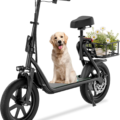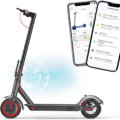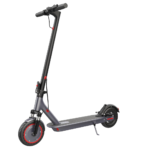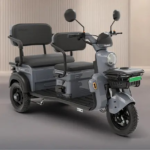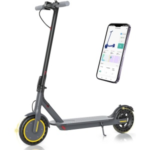- Home
- Scooters
- Electric Scooters
- Roinside UP8 Pro
Roinside UP8 Pro
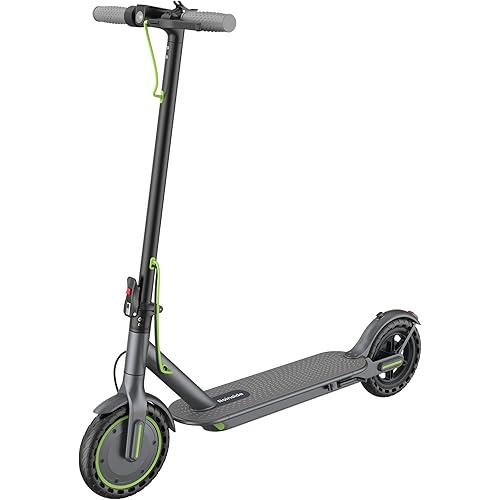

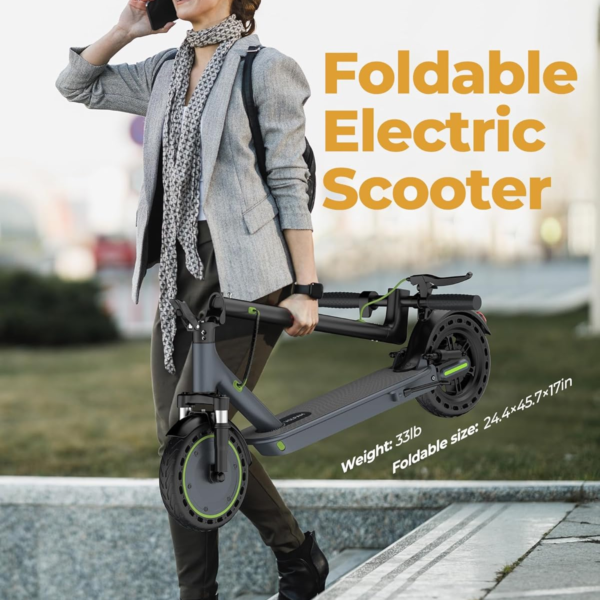
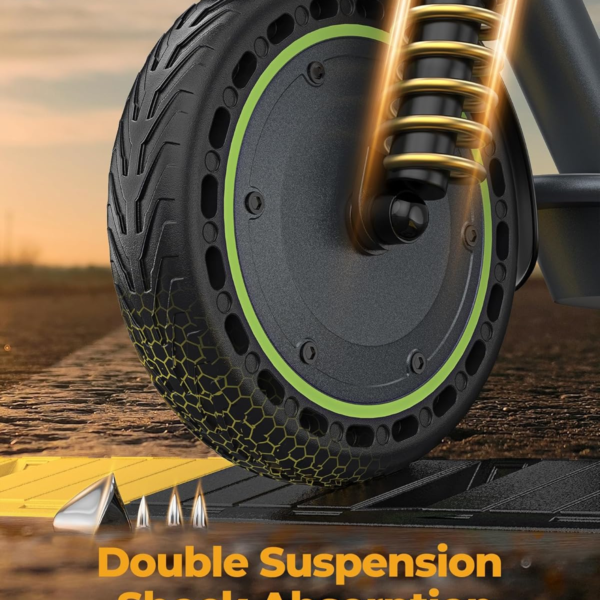
- Battery Range: 15–23 miles (24–37 km)
- Top Speed: 19 mph (31 km/h)
- Motor Power: 350 W
- Weight Capacity: 265 lb (120 kg)
- Charging Time: ~5 h
- Scooter Weight: 28.0 lb (12.7 kg)
PROS
- Solid 8.5″ tires resist flats
- Dual braking: rear disc + electronic (EABS)
- Compact 1-step folding
- Bluetooth app with basic lock/settings
- 265 lb (120 kg) max load
CONS
- IP rating not specified
- Solid tires ride harsher than pneumatics
- Limited top speed for heavy riders
Table of contents
- What Is the Roinside UP8 Pro?
- How the Roinside UP8 Pro Works
- Key Specifications
- Design & Build Quality
- Performance Fundamentals
- Battery, Range & Efficiency
- Ride Quality & Comfort
- Braking & Safety Features
- Portability & Daily Usability
- Maintenance & Care
- Weather & Seasonal Considerations
- Roinside UP8 Pro vs Alternatives
- Who the Roinside UP8 Pro Is (and Isn’t) For
- FAQs
- Glossary
- Final Notes on Ownership
The Roinside UP8 Pro is a compact, commuter-focused electric scooter that aims to make short urban trips predictable, efficient, and low-maintenance. Moreover, it pairs a 36-volt class powertrain with solid 8.5-inch tires, a dual-braking setup, and a simple folding mechanism. Because it favors practicality over flash, it suits new riders, students, multi-modal commuters, and anyone who wants dependable point-to-point transport without fiddly upkeep.
Below you’ll find a clear, beginner-friendly Roinside UP8 Pro overview that explains how it works, what you can expect in daily use, and how to keep it in good shape over time. In addition, you’ll see realistic notes about range, ride feel, and care routines that help ownership stay simple.
Looking for the official spec sheet and photos? Check the Roinside UP8 product page.
What Is the Roinside UP8 Pro?
The Roinside UP8 Pro is a lightweight, foldable kick-style e-scooter designed for city streets, bike paths, and campus routes. Consequently, the learning curve stays short, since its hub motor is tuned for steady takeoffs and consistent cruising rather than hot-rod launches. The deck height and handlebar layout feel familiar if you’ve used other commuter scooters, so you can step on and ride with confidence after a brief practice session.
Furthermore, the scooter uses solid (airless) 8.5-inch tires, which eliminate punctures and reduce maintenance. It also employs a disc + electronic braking system to keep stops predictable in everyday traffic. Meanwhile, the control layout remains intuitive, which helps new riders focus on situational awareness rather than fiddling with settings.
Marketing language for the UP8 family emphasizes range in the low-20-mile bracket, a top speed around the high-teens (mph), and a maximum rider weight in line with typical commuter models. However, those numbers always depend on rider mass, temperature, hills, and speed settings. Even so, the UP8 Pro’s configuration is built to handle the city grind with minimal fuss.
How the Roinside UP8 Pro Works
Think of the motor, controller, and battery as a small orchestra that responds to your inputs. As a result, the scooter feels composed rather than twitchy.
- Motor (rear hub): A brushless DC hub motor sits inside the rear wheel. When you press the thumb throttle, it delivers smooth, quiet torque directly to the ground—no chain, no belts, no extra moving parts. Consequently, routine upkeep stays simple.
- Controller: The controller is the conductor. It meters current from the battery to the motor based on your throttle input, speed mode, and load. In practice, that means gentle takeoffs in Eco and stronger pull in Sport; therefore, you can match power to conditions.
- Battery: A 36-volt lithium-ion pack (charges to 42V) stores energy for your ride. On Pro-labeled UP8 variants, capacity typically sits in the low-to-mid-400 Wh range. Thus, real-world range lands squarely in commuter territory when you ride at a steady pace.
- Throttle: A right-hand thumb paddle gives you linear control. Short presses and small movements translate to modest speed changes, which helps new riders avoid jerky starts. Additionally, it encourages smooth, energy-saving habits.
- Brakes: A mechanical rear disc does the heavy lifting when you pull the lever. Meanwhile, a front-end electronic brake (E-ABS) reduces wheel lockup and recovers a bit of energy. The two systems combine for consistent stops that feel firm without being grabby.
If you’ve never ridden an e-scooter, picture a quiet, electric-bicycle start but with a standing stance and a compact wheelbase. You twist nothing; instead, you press the thumb paddle to go and squeeze the lever to slow. Consequently, the controls become second nature within minutes.
Key Specifications
Values reflect manufacturer-stated figures for the UP8/UP8 Pro configuration class plus common commuter-scooter norms for this platform. Naturally, expect variation in real-world use based on rider weight, terrain, temperature, and tire condition.
| Category | Details |
|---|---|
| General | Adult commuter electric scooter; foldable aluminum frame; rider weight limit up to 265 lb (120 kg); solid 8.5-inch tires (216 mm). |
| Performance & Power | Rear-hub brushless DC motor rated around 350 W nominal (peaks higher under load); top speed up to ~19 mph (≈ 30 km/h); typical urban hill handling on gentle grades (see “Performance Fundamentals”). |
| Battery, Charging & Electrical | 36V lithium-ion pack (charges to 42V); ~400–450 Wh class capacity on Pro builds; ~4–5 hour charge with a 42V, 1.5–2A charger; electronic brake with E-ABS; integrated LED display. |
| Build & Dimensions | Aluminum deck and stem; single-action folding latch with rear fender hook; folded approx. 25 × 4.8 × 18 in (≈ 63.5 × 12.2 × 45.7 cm); package size often around 43.5 × 21 × 6.2 in for shipping. |
| Safety & Control | Rear mechanical disc + front electronic brake (E-ABS); front LED headlight; tail/brake light; side reflectors; speed modes (Eco/Standard/Sport). |
| Features & Extras | App connectivity on supported units (speed setting, lock, ride stats); solid tires for puncture-free commuting; bell; kickstand; optional comfort-oriented shock elements on Pro-branded variants; cruise control may be available via settings on certain trims. |
| Warranty & Compliance | Commonly advertised 12-month limited warranty for key components; many listings indicate UL-style electrical compliance; always verify the label on your specific unit and charger. |
Note: Manufacturers sometimes market “quadruple shock absorption” on Pro trims. In practice, this usually means a combination of small springs and chassis compliance rather than large hydraulic dampers. Therefore, treat it as comfort-oriented hardware, not off-road suspension.
Design & Build Quality
Frame and deck. The frame uses boxy aluminum extrusions with a straightforward weld layout. As a result, the structure feels rigid under normal commuting loads. The deck is long enough for a staggered stance, and its grippy surface keeps shoes from sliding when roads get dusty. Additionally, edges are generally rounded, so they don’t snag pant legs while you step on.
Stem and latch. The stem is a single-tube design with a quick-fold latch at the base. It clicks into the rear fender hook when folded, which makes one-hand carrying easier. Even so, you’ll want to periodically check latch tightness. When set correctly, the stem feels stable at cruising speeds; conversely, a loose latch can introduce wobble.
Cockpit layout. The display sits centered or slightly right-biased, with a thumb throttle on the right and a brake lever on the left. A bell integrated into the lever clamp is typical. Furthermore, mode changes generally require a quick multi-press on the display’s primary button, which keeps the controls uncluttered.
Fit and finish. Expect a commuter-grade finish: powder-coated frame, consistent panel seams, and sealed deck screws. Cable routing is tidy, exiting the stem with strain relief and running along the deck’s side. While it’s not a luxury presentation, it is cohesive and practical.
Performance Fundamentals
Acceleration feel. In Eco mode, starts are gentle and confidence-building. Standard or Sport modes unlock more current, so the scooter pulls steadily to the high-teens (mph). Because the hub motor is modestly rated, it doesn’t surge; instead, it builds speed smoothly, which helps with traction on dusty paths and painted crosswalks. Moreover, that progressive feel reduces rider fatigue on stop-and-go routes.
Stability at speed. With a compact wheelbase and 8.5-inch wheels, stability mostly depends on stance and pavement quality. At around 15–18 mph, the UP8 Pro tracks straight if the stem latch is snug and tires are in good condition. Additionally, keeping a light bend in your knees absorbs chatter from rough asphalt and reduces hand tingles.
Hill-climb behavior. On 7–10% grades, speed will dip, and you may find that shifting into a “Standard” mode keeps current draw manageable while maintaining motion. Short, punchy climbs are fine. However, long, sustained hills will reduce speed further; therefore, plan alternate routes where possible or allow extra time.
Noise and vibration. The brushless hub stays quiet. Solid tires do transmit more small bumps than pneumatic ones, but the deck and stem soak some of it up, and any Pro-variant springs add a bit of extra give. Consequently, ride comfort remains acceptable on typical city pavement.
Battery, Range & Efficiency
Rated vs real-world range. Manufacturer claims in this class hover around 20–23 miles per charge at moderate speeds on flat ground with a lightweight rider. In mixed urban riding, a practical expectation is 10–16 miles for a 175–200 lb rider using Standard/Sport modes with a few inclines. That’s still one to two commute days for many users; moreover, careful throttle habits can extend it.
What affects range most:
- Rider mass & cargo: Heavier loads increase current draw, especially at takeoff. Consequently, range falls when you carry a backpack or groceries.
- Speed & wind: Aerodynamic drag rises quickly with speed; even a 2–3 mph reduction can add meaningful range. In headwinds, consider Eco to save energy.
- Terrain & temperature: Cold batteries deliver fewer watt-hours; hills consume energy in bursts. Therefore, expect shorter range on winter mornings or hilly loops.
- Tire condition: Solid tires don’t go soft, but worn treads and rough surfaces add rolling losses. Regular inspections help minimize surprises.
Charging best practices.
- Let the scooter cool a bit after a hard ride before charging; consequently, cells avoid unnecessary heat stress.
- Use the supplied 42V charger on a stable outlet, and avoid extension cords when you can.
- For storage over a week, leave 40–60% charge and park in a cool, dry place.
- Avoid full discharges; lithium-ion cells prefer shallow cycles.
- Inspect the charge port cap so dust and moisture stay out; afterward, reseat it firmly.
Efficiency tips. Start in Eco when pulling away from lights, then step to Standard as you clear traffic. Keep a steady mid-teens mph cruise. Additionally, anticipate stops and use regen early so the mechanical disc does less work. Over time, those habits noticeably extend range.
Ride Quality & Comfort
Tires. The 8.5-inch solid tires are puncture-proof and maintenance-light. On smooth asphalt they roll quietly; on cracked pavement they pass small vibrations into the deck. This trade-off is intentional: you give up a bit of cushion to eliminate flats. On the upside, you’ll never miss work because of a pinch puncture.
Suspension behavior. Pro-branded units may add small spring elements that take the edge off expansion joints. They help most at low to medium speeds. However, on broken surfaces or cobblestones, soften your knees and reduce speed; that rider input matters more than any small spring. Consequently, you maintain control and comfort.
Ergonomics. The deck supports a natural, staggered stance. Handlebars are a commuter width—narrow enough for doorways, wide enough for leverage. There’s minimal stem flex when the latch is correctly tensioned. If you feel oscillation at higher speeds, slow down and check the latch preload; then, resume once it’s snug.
Noise & rattle control. Periodically tighten fender screws, display mounts, and brake hardware. As a result, the ride stays quiet and hardware lasts longer.
Braking & Safety Features
Disc + E-ABS. The rear mechanical disc provides the main stopping force. The electronic brake up front adds a smoothing effect and reduces lockups on slick paint. Lever travel is short, and bite arrives about halfway through the pull, which gives you room to modulate on downhill sections. Additionally, learning to ease into braking improves stability.
Lights & reflectors. A bright front LED helps you stay visible. The rear light brightens under braking. Side reflectors bolster cross-traffic visibility. For night rides, consider a helmet-mounted light for better depth perception and aim the headlight slightly downward to avoid dazzling others.
Water exposure. Many commuter scooters in this class advertise some splash resistance, yet not all list an official IP rating. Without a published rating on your exact unit, treat wet use conservatively: slow down, avoid standing water, and dry the scooter after riding through drizzle. In the long run, that habit protects connectors and bearings.
Safe stopping habits.
- Shift weight slightly rearward and bend knees during hard stops; thereby, you keep traction on the rear wheel.
- Start braking earlier on cold mornings; rubber compounds harden a bit in low temps.
- Keep the rotor clean; a quick wipe with isopropyl alcohol improves consistency and reduces squeal.
Portability & Daily Usability
Weight and carry. The UP8 Pro’s carry mass lands in a commuter-friendly range—light enough to lift into a trunk or up a short flight of stairs, yet substantial enough to feel planted on the road. Thus, it fits apartment life and train platforms alike. Use the folded stem as a handle and support the deck with your free hand to keep it level.
Folding routine. Flip the base latch, lower the stem, and clip it to the rear fender hook. Unfold in reverse: unhook, raise the stem, lock the latch, and confirm there’s no play before riding. With practice, the fold/unfold takes seconds; furthermore, the process becomes automatic after a week of commuting.
Storage. Because the scooter is slim when folded (roughly 25 × 4.8 × 18 in), it slides beside a desk, under a table, or into a closet. For apartments, place a small mat by the door to catch grit and protect floors. Additionally, a soft strap can make stair carries more comfortable.
Security habits. Bring the scooter inside whenever possible. If you must lock it, route a compact U-lock through the deck cutouts or frame and a fixed object, and use the electronic lock in the app (if your unit supports it) as an extra layer. Nevertheless, never leave it folded and unattended in busy public spaces.
Maintenance & Care
Weekly (5 minutes).
- Check the folding latch; tighten if there’s play.
- Spin the wheels; listen for rub and verify the brake rotor runs clean.
- Look over fasteners (fenders, display, lever clamps) and snug as needed. As a result, you prevent rattles before they start.
Monthly.
- Inspect brake pads; if the lever travel grows long or you hear squeal, adjust the caliper and clean the rotor.
- Wipe dust from the deck screws and re-seal any lifted caps.
- Review app firmware (if available) and only update when the battery is at least 50%; afterward, test brakes in a safe area.
Quarterly.
- Check wheel bearings for side play; if present, service or replace.
- Examine tire tread; solid tires wear slowly, but replace them when the pattern smooths out.
- Inspect the charge port and cap; replace the cap if it’s loose or cracked to keep debris out.
Charging hygiene.
- Keep the charger on a hard, ventilated surface.
- Coil the cable loosely—no sharp bends at the barrel connector.
- Unplug after the LED shows full; although the scooter manages float, unplugging reduces heat exposure.
Weather & Seasonal Considerations
Rain. Traction falls quickly on wet paint, metal grates, and leaves. Therefore, reduce speed, brake earlier, and keep inputs smooth. After wet rides, towel the deck, dry the rotor, and let the scooter sit unfolded to evaporate residual moisture.
Heat. Lithium-ion packs dislike sustained high temperatures. Don’t leave the scooter in a closed car on hot days. If the deck feels hot after a climb, give it a minute before you plug in; consequently, cells cool and charging stress drops.
Cold. Expect temporary range drops below ~50°F (10°C). Plan shorter trips or lower speed modes. Because rubber hardens in cold weather, adjust your braking distance and avoid sudden steering inputs.
Dust & grit. City grit acts like sandpaper. Wipe the deck after rides and keep the rotor clean. Additionally, store the scooter off the ground to reduce dust exposure.
Roinside UP8 Pro vs Alternatives
Against ultra-budget commuters. The Roinside UP8 Pro offers a more rounded package than bare-bones scooters: stronger braking, app features on supported units, and a steadier top-end cruise. If you’re upgrading from a toy-class kick-assist model, you’ll notice the difference immediately; moreover, you’ll spend less time troubleshooting.
Against mid-tier commuters with pneumatic tires. Scooters with air-filled tires ride softer and grip better on rough pavement, but they introduce puncture risk and require pressure checks. If you hate flats and prefer a zero-upkeep tire, the UP8 Pro’s solid rubber appeals. On the other hand, riders who value plush comfort above all may still prefer tubes.
Against heavier performance scooters. High-output models climb faster, brake harder, and push top speeds beyond what most cities allow. The trade-offs are weight, size, and cost. By contrast, the UP8 Pro remains a nimble, apartment-friendly tool designed to take transit connections and stairwells in stride.
Where the UP8 Pro excels.
- Daily commutes on predictable pavement.
- Riders who prioritize no-flat tires and a simple fold.
- Short trips where charging every couple of days is acceptable; additionally, light riders can stretch intervals further.
Where a different class may fit better.
- Long, steep hills beyond 7–10% for extended durations.
- Rough, broken surfaces where pneumatic tires shine.
- High-speed suburban arterials with fast traffic; alternatively, choose a model with larger wheels and stronger brakes.
Who the Roinside UP8 Pro Is (and Isn’t) For
Ideal for:
- Students and campus riders who want a reliable, low-maintenance way to cross town; plus, the quick fold helps in crowded halls.
- Multi-modal commuters who combine rides with trains or buses and need a quick fold and compact footprint.
- First-time owners who value easy controls and gentle power delivery; consequently, confidence builds fast.
- Flat-terrain commuters who prefer consistency over peak performance.
Not ideal for:
- Aggressive riders seeking 25+ mph blasts and sport-tuned suspension.
- Long-grade climbers who face sustained steep hills daily; in that case, a higher-power class suits better.
- Rough-surface explorers who ride broken asphalt or gravel; instead, they’ll be happier with larger pneumatic tires.
FAQs
1) Is the battery user-removable on the Roinside UP8 Pro?
No. The pack is deck-integrated. You charge through the external port using the supplied 42V charger. Consequently, charging remains quick and tidy.
2) What real-world range should I expect?
Plan for 10–16 miles of mixed urban riding for an average-weight adult using Standard/Sport modes with a few inclines. Riding slower and lighter extends range; conversely, cold weather and hills shorten it.
3) Does the Roinside UP8 Pro have cruise control?
Some app-connected UP8 family units offer speed hold via settings. It is not universally documented, so treat it as a bonus feature if present rather than a guaranteed inclusion.
4) What’s the best tire pressure for the UP8 Pro?
The scooter uses solid tires, so there’s no pressure to set. Instead, inspect for cuts or excessive wear and maintain clean tread for consistent grip.
5) Can I ride it in the rain?
Light splashes happen in city life, but without a clearly stated IP rating on your exact unit, it’s prudent to avoid wet conditions and always dry the scooter after incidental moisture. As a result, electronics last longer.
6) How often should I adjust the brakes?
Check lever feel weekly. If the lever pulls closer to the bar than usual, adjust the cable at the caliper and clean the rotor. Pads last a long time at commuter speeds, especially if you use regen early; moreover, smooth riding reduces wear.
7) Where can I find a concise Roinside UP8 Pro overview?
Right here. This guide explains the platform, its strengths, trade-offs, and the habits that keep it running smoothly; additionally, it clarifies care routines for lasting reliability.
Glossary
- Ah (Amp-hour): Battery capacity measure. Higher Ah usually means longer range if voltage stays the same; however, Wh tells the full story.
- Wh (Watt-hour): Battery energy (voltage × capacity). Consequently, it’s a stronger indicator of range than Ah alone.
- Controller: The electronic module that meters battery power to the motor based on throttle and modes; therefore, it shapes acceleration feel.
- Regen (Regenerative Braking): Uses the motor to slow the scooter while recovering a little energy; additionally, it reduces brake-pad wear.
- E-ABS: Electronic anti-lock strategy that limits wheel lock and smooths braking; as a result, stops feel more controlled.
- Stem Flex: Small bending or play in the handlebar stem; excessive flex can reduce stability, so keep the latch snug.
- IP Rating: Ingress Protection code for dust/water resistance; since not all scooters publish it, ride cautiously in wet conditions.
- Hub Motor: Motor built into the wheel hub—quiet, low-maintenance, and efficient for city speeds; moreover, it simplifies drivetrains.
- Solid Tire: Airless rubber tire that can’t puncture; however, it rides firmer than pneumatic alternatives.
- Pneumatic Tire: Air-filled tire with a tube or tubeless construction; it improves comfort but can puncture.
- Peak Power: Short bursts of motor output above nominal rating, used during starts and climbs; consequently, hills feel easier.
- Eco/Standard/Sport Modes: Software limits for speed and current; choose based on range and terrain, then adjust as conditions change.
- Deck: The platform you stand on; longer decks allow more stance options and better comfort.
- UL-Style Compliance: Safety testing standard frequently referenced for micro-mobility electronics; always check your device label.
- Electronic Lock: Software lock that resists casual tampering and disables throttle output; still, use a physical lock when parking.
Final Notes on Ownership
To get the most from your Roinside UP8 Pro, ride deliberately and maintain a simple routine. First, keep speeds in the mid-teens mph on busy streets to extend range and reduce sudden braking. Second, use Eco for start-ups, Standard for cruising, and Sport only when you need a quick pass or to keep momentum on short hills. Third, clean, inspect, and tighten little things before they become bigger ones. Consequently, you’ll enjoy a quieter ride and longer component life.
If you value predictability, low running effort, and a folded footprint that fits real life, this scooter delivers what matters most for the city commute. Moreover, it remains approachable for beginners while still satisfying daily riders who want predictable performance.
For ride impressions and test-style observations, see our Roinside UP8 review.
Specifications
General
| Model The Model specifies the exact version or name of the scooter. It helps identify its unique design, features, and specifications within the manufacturer’s product line. Knowing the model makes it easier to compare options, find compatible accessories, or look up support information. | UP8 Pro |
| Brand The Brand identifies the manufacturer or company that designs and produces the scooter. A trusted brand is a sign of quality, reliability, and good customer support. Well-known brands often have higher standards for safety, performance, and after-sales service, giving you more confidence in your purchase. | Roinside |
| Release Date The Release Date indicates when the scooter model was officially launched on the market. This helps you know how current the design, technology, and features are. A newer release date often means updated components, improved performance, and the latest safety or smart features. | 17 November 2025 |
| Recommended Age Recommended Age indicates the minimum age range that the scooter is designed for, based on safety, size, and ease of use. Following the recommended age helps ensure that riders can handle the scooter’s speed, weight, and controls comfortably and safely. Always check local laws and use protective gear, especially for younger riders. | +16 |
Performance & Power
| Motor Power (Wattage) What it means: The motor power, measured in watts (W), shows how strong the scooter’s electric motor is. Why it matters: Higher wattage usually means better acceleration, more torque, and improved performance on hills or rough terrain. For example, a 250W motor is good for flat city roads and light riders, while a 500W or 1000W motor provides more power for faster speeds or climbing steep inclines. | 350 W front hub |
| Top Speed The Top Speed indicates the maximum speed that the scooter can reach under optimal conditions. It’s usually measured on level ground with a fully charged battery and an average rider weight. A higher top speed allows you to travel longer distances faster, but always ensure you ride within legal speed limits and your personal comfort zone for safety. | 19 mph (31 km/h) |
| Battery Capacity Battery Capacity refers to the total amount of energy the scooter’s battery can store, usually measured in ampere-hours (Ah) or watt-hours (Wh). A higher battery capacity means you can ride longer distances on a single charge, reducing the need for frequent recharging. Keep in mind that actual range can vary depending on rider weight, terrain, speed, and weather conditions. | 36 V 9.0 Ah (323 Wh) |
| Estimated Range per Charge The Estimated Range per Charge indicates the average distance the scooter can travel on a single full battery charge. This range is calculated under optimal conditions, such as flat terrain, moderate speed, and average rider weight. Real-world range may vary depending on riding style, terrain, weather, and load. A longer range means fewer recharges and greater freedom for longer trips. | 15–23 miles (24–37 km) |
| Hill Climb Ability Hill Climb Ability describes the maximum incline or slope that the scooter can handle while maintaining stable performance. It’s typically expressed as a percentage or in degrees. A higher hill climb rating means the scooter can tackle steeper hills without losing too much speed or power. Actual climbing performance may vary based on rider weight, battery charge, and terrain conditions. | Not specified |
| Drive System The Drive System refers to how power from the motor is delivered to the wheels. Electric scooters typically use either a hub motor (directly integrated into the wheel) or a chain/belt drive system. A high-quality drive system ensures smooth acceleration, efficient power transfer, and low maintenance. The choice of drive system affects performance, noise level, and overall ride experience. | Front hub (FWD) |
Charging & Electrical
| Charging Time Charging Time indicates how long it takes to fully recharge the scooter’s battery from empty to 100% using the standard charger provided. Faster charging means less downtime and more time on the road. Actual charging time may vary slightly depending on battery capacity, charger output, and environmental conditions. | Approx. 5 hours |
| Battery Type Battery Type refers to the specific technology used in the scooter’s battery, which affects performance, lifespan, weight, and charging time. Most modern electric scooters use high-quality lithium-ion (Li-ion) batteries because they offer a good balance of energy density, durability, and low maintenance. A reliable battery type ensures consistent power delivery and longer riding ranges. | Lithium-ion pack |
| Removable Battery A Removable Battery means the battery pack can be easily detached from the scooter for convenient charging and replacement. This feature allows you to charge the battery separately, swap it with a spare for extended range, or securely store it indoors in extreme weather. Removable batteries add flexibility and make it easier to keep your scooter powered up wherever you are. | Non-removable internal battery (fixed pack) |
| Regenerative Braking Regenerative Braking is an energy-saving feature that converts some of the energy normally lost during braking back into battery power. When you slow down or brake, the motor works in reverse to generate electricity, which helps extend the scooter’s range and improves overall efficiency. This system also reduces wear on traditional brake components, leading to lower maintenance over time. | Yes (via electronic brake) |
| Lighting Lighting refers to the built-in front and rear lights that enhance visibility and safety when riding in low-light conditions or at night. Good lighting helps you see the road ahead and ensures that other road users can see you. Many scooters include LED headlights, taillights, and sometimes brake lights or side reflectors for added safety and compliance with local traffic regulations. | LED headlight + rear LED/brake + reflectors |
Build & Dimensions
| Scooter Weight Scooter Weight refers to the total weight of the scooter when fully assembled, including the battery. This affects how easy it is to carry, lift, and store the scooter when not in use. A lighter scooter is more portable and convenient for commuting, especially if you need to carry it upstairs or onto public transport. Keep in mind that a sturdy frame and quality components may add to the weight but also contribute to better durability and ride stability. | 28.0 lb (12.7 kg) |
| Maximum Rider Weight Maximum Rider Weight indicates the highest rider weight that the scooter is designed to safely support while maintaining optimal performance and stability. Staying within this limit helps ensure reliable acceleration, braking, and climbing ability, and it protects the frame, suspension, and motor from excessive strain. Exceeding the recommended limit may reduce performance and increase wear on components. | 265 lb (120 kg) |
| Deck Size Deck Size refers to the dimensions of the scooter’s standing platform. A wider and longer deck provides more foot space, allowing you to stand comfortably and adjust your stance while riding. A well-sized deck improves balance and stability, especially on longer rides or at higher speeds. Compact decks, on the other hand, help keep the scooter lightweight and portable. | Low deck; foldable stem |
| Handlebar Height Handlebar Height refers to the distance from the deck to the handlebars, which affects your riding posture and comfort. An appropriate handlebar height helps you maintain good balance, reduces strain on your back and arms, and makes steering more comfortable. Some scooters have adjustable handlebars to fit riders of different heights, while others have a fixed height for a streamlined design. | Not specified |
| Folding Mechanism The Folding Mechanism describes how easily and securely the scooter can be folded for carrying and storage. A well-designed folding system lets you quickly collapse the scooter into a compact size, making it convenient to transport on public transit, store under a desk, or fit into a car trunk. Look for sturdy latches and safety locks to ensure the scooter stays firmly in place when folded or unfolded. | Quick-fold latch |
| Dimensions Folded Dimensions indicate the size of the scooter when it’s fully folded. This measurement shows how much space the scooter will take up when stored or carried, making it easier to check if it will fit in your car trunk, under a desk, or in a closet. Compact folded dimensions are ideal for commuters who need to bring their scooter on public transport or store it in tight spaces. | Folded: Not specified; Unfolded: Not specified |
| Material Material refers to the primary construction materials used for the scooter’s frame and key components. High-quality materials like aircraft-grade aluminum, reinforced steel, or durable composites provide strength, stability, and a lighter overall weight. A sturdy material ensures the scooter can handle daily wear and tear while maintaining safety and performance. | Aluminum alloy |
Safety & Control
| Brake Type(s) Brake Type(s) describe the braking systems the scooter uses to help you slow down or stop safely. Common brake types include mechanical brakes (like drum or disc brakes), electronic brakes, and foot brakes. Many scooters combine multiple braking systems for added safety and shorter stopping distances. The type and quality of brakes affect your control, especially when riding at higher speeds or on slopes. | Rear disc + electronic (EABS) |
| Suspension Suspension refers to the system that absorbs shocks and vibrations while riding, providing a smoother and more comfortable ride over uneven or rough surfaces. Scooters may have front suspension, rear suspension, or dual suspension for better shock absorption and stability. Good suspension helps reduce rider fatigue and improves control, especially when riding on bumpy roads or off-road paths. | Not specified |
| Tire Type Tire Type refers to the kind of tires the scooter uses, which directly affects ride comfort, traction, and maintenance. Common types include solid (airless) tires, pneumatic (air-filled) tires, or hybrid options. Pneumatic tires offer better shock absorption and a smoother ride on rough surfaces, while solid tires are puncture-proof and require less upkeep. The right tire type helps ensure safe handling and a comfortable ride in different conditions. | 8.5″ solid (honeycomb) street |
| Tire Size Tire Size indicates the diameter and width of the scooter’s tires, which affect ride comfort, stability, and how well the scooter handles different terrains. Larger tires generally offer better shock absorption and a smoother ride over bumps and rough surfaces, while smaller tires keep the scooter lighter and more portable. Choosing the right tire size helps ensure a balance between agility and comfort. | 8.5-inch |
| Kickstand The Kickstand is a built-in stand that allows you to park your scooter upright when it’s not in use. A sturdy kickstand keeps the scooter stable and prevents it from tipping over, protecting it from scratches and damage. It also makes storing and accessing your scooter more convenient, whether you’re at home, work, or on the go. | Side kickstand |
| Water Resistance Rating Water Resistance Rating indicates how well the scooter is protected against water and moisture, usually shown as an IP (Ingress Protection) rating. This rating helps you understand whether the scooter can handle light rain, splashes, or wet roads without damage. While most scooters are not fully waterproof, a good water resistance rating adds peace of mind when riding in changing weather conditions. Always avoid deep puddles or submerging the scooter to protect its electrical components. | Not specified |
Features & Extras
| Display/Console The Display (or Console) shows important real-time information about your ride, helping you monitor your scooter’s status at a glance. Typical displays show speed, battery level, distance traveled, and riding mode. Some models also include additional features like Bluetooth connectivity, app integration, or backlighting for better visibility at night. A clear and easy-to-read display enhances safety and convenience on every trip. | LED display (speed, battery, mode) |
| Ride Modes Ride Modes refer to the different speed and power settings you can choose to match your riding style or road conditions. Common modes include eco for maximum range and energy efficiency, standard for everyday balance, and sport or turbo for higher speed and stronger acceleration. Switching between ride modes allows you to customize performance, conserve battery, and ride safely in various environments. | Not specified |
| Smart App Connectivity Smart App Connectivity lets you pair your scooter with a dedicated mobile app via Bluetooth. Using the app, you can monitor real-time ride stats like speed, battery level, and range, adjust settings such as ride modes or cruise control, lock the scooter for added security, and sometimes receive firmware updates. This feature adds convenience and allows you to personalize your riding experience right from your smartphone. | Bluetooth app (lock, basic settings) |
| Anti-Theft System The Anti-Theft System helps protect your scooter from unauthorized use or theft. This feature can include built-in alarms, electronic motor locks, GPS tracking, or remote locking through a mobile app. A good anti-theft system provides peace of mind when parking your scooter in public spaces, adding an extra layer of security to safeguard your investment. | App lock |
| Cruise Control Cruise Control allows you to maintain a steady speed without continuously holding the throttle. This feature makes longer rides more comfortable by reducing hand fatigue and providing a smoother, more relaxed riding experience — especially on flat, open roads or bike lanes. For safety, cruise control can usually be easily activated or deactivated while riding. | Yes (cruise control) |
| Accessories Included Accessories Included lists the additional items that come with the scooter to enhance your riding experience and convenience. Common accessories may include a charger, kickstand, bell, lights, phone holder, or carrying strap. These extras add value by making your scooter safer, easier to use, and ready to ride straight out of the box. | Scooter, 42V charger (1.5–2A), tools, manual |
Warranty & Compliance
| Warranty Period The Warranty Period indicates how long the manufacturer guarantees the scooter against defects in materials and workmanship under normal use. A good warranty provides peace of mind, showing the brand’s confidence in its product quality. Always check what parts are covered, such as the frame, battery, and motor, and follow the maintenance guidelines to keep your warranty valid. | Region-dependent |
| Certifications Certifications confirm that the scooter meets specific safety, quality, and environmental standards set by recognized organizations or regulatory bodies. Common certifications may include CE, RoHS, UL, or other local compliance marks, depending on your region. These certifications ensure that the scooter is manufactured to high standards and is safe and legal to use in your country. | Region-dependent |





